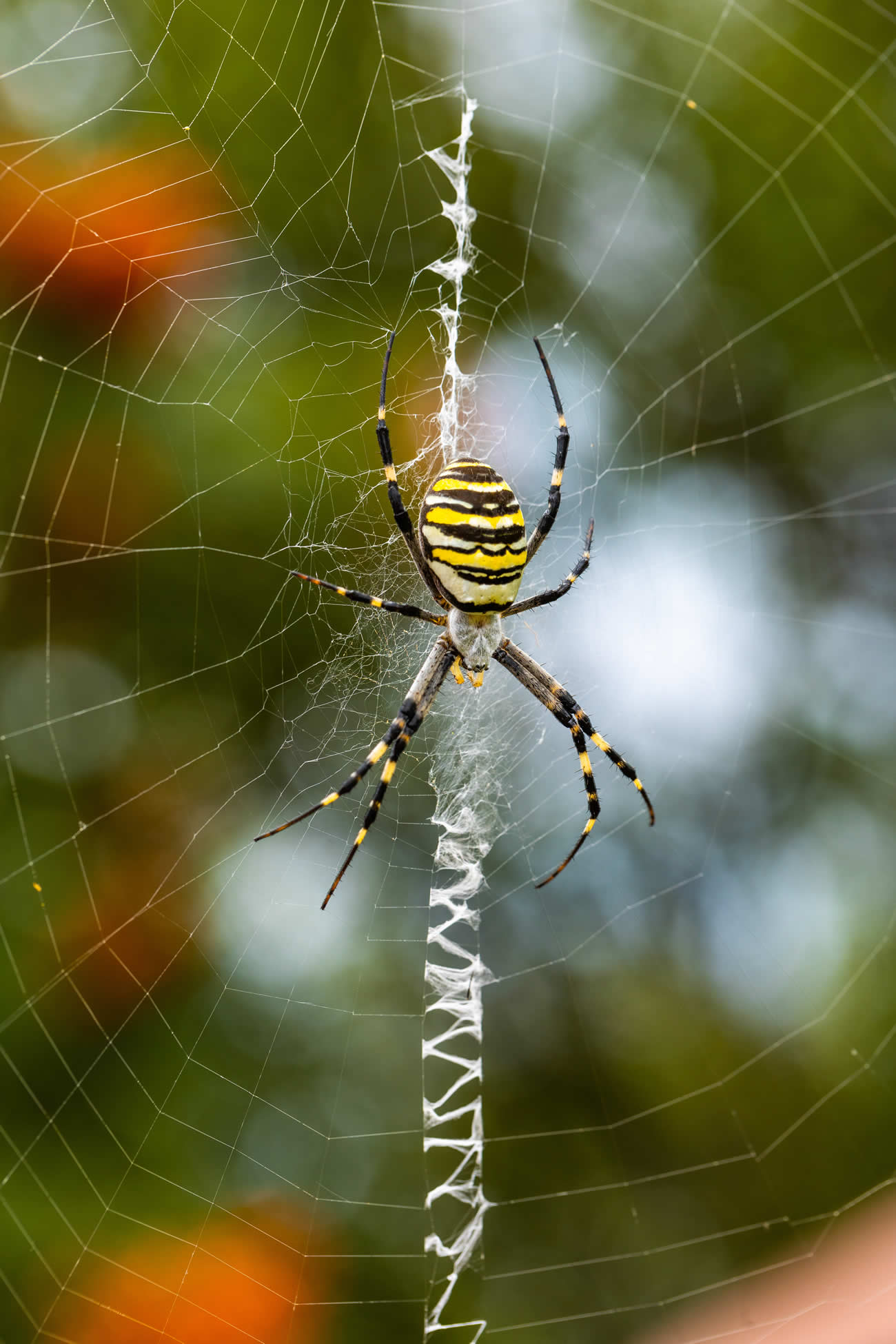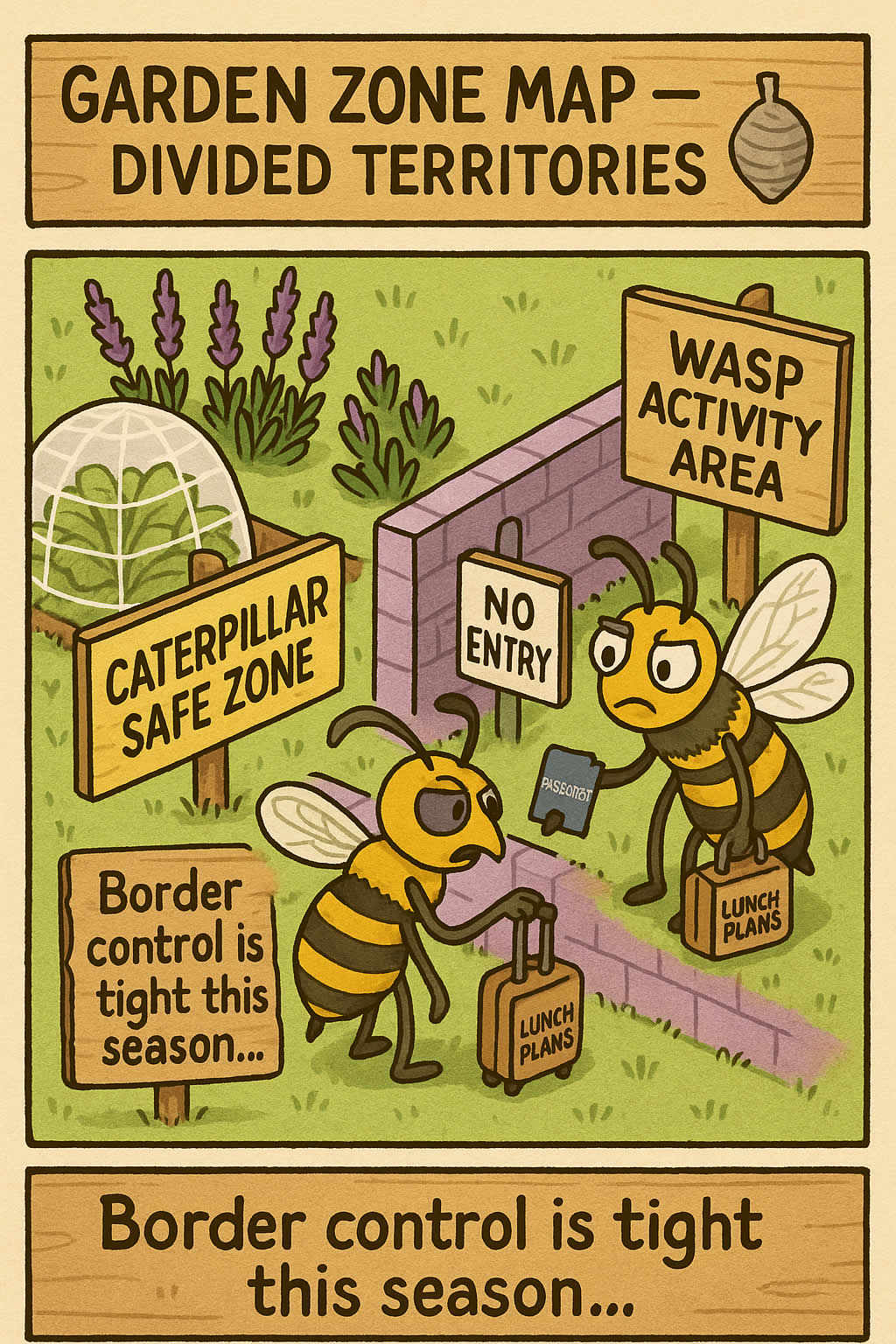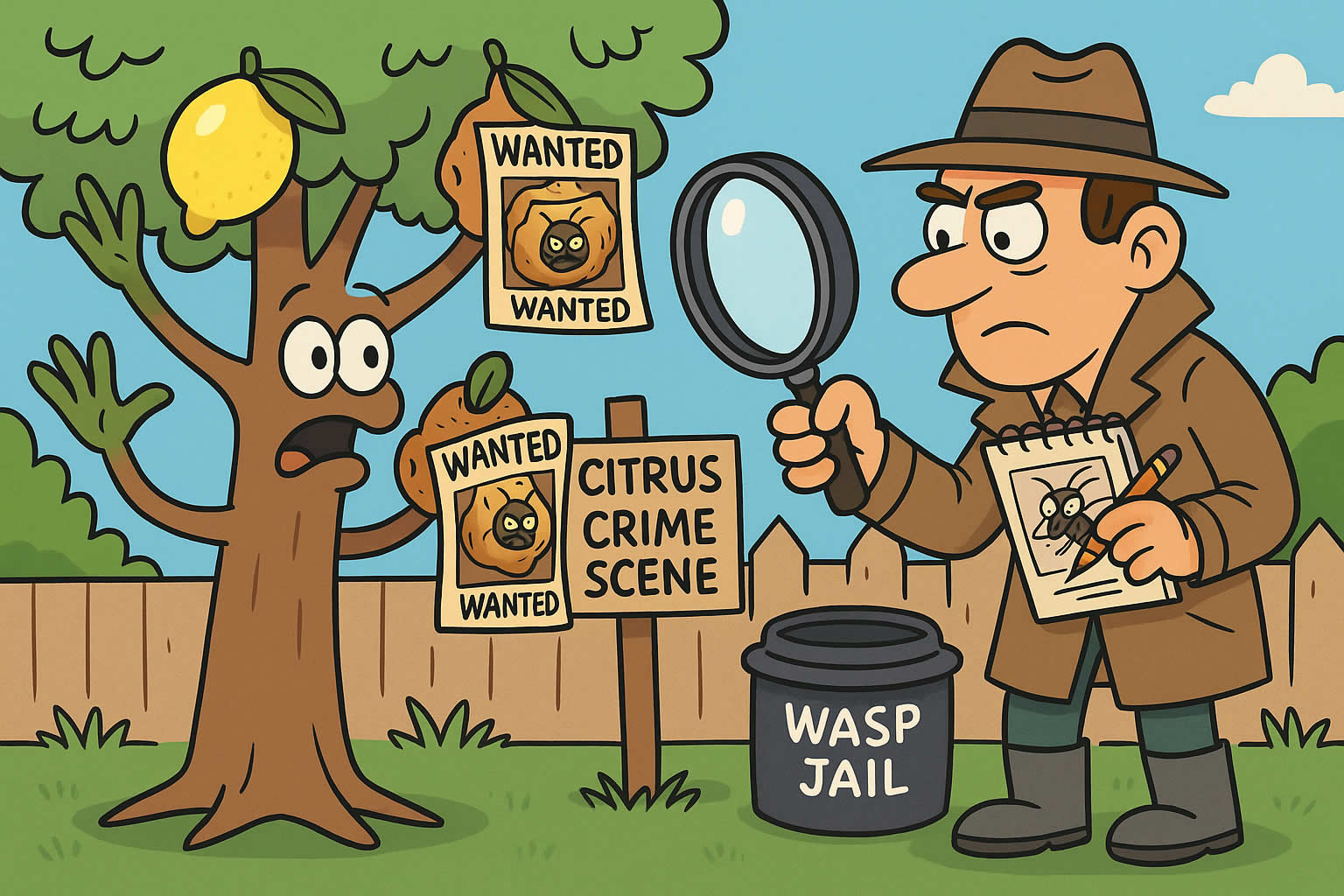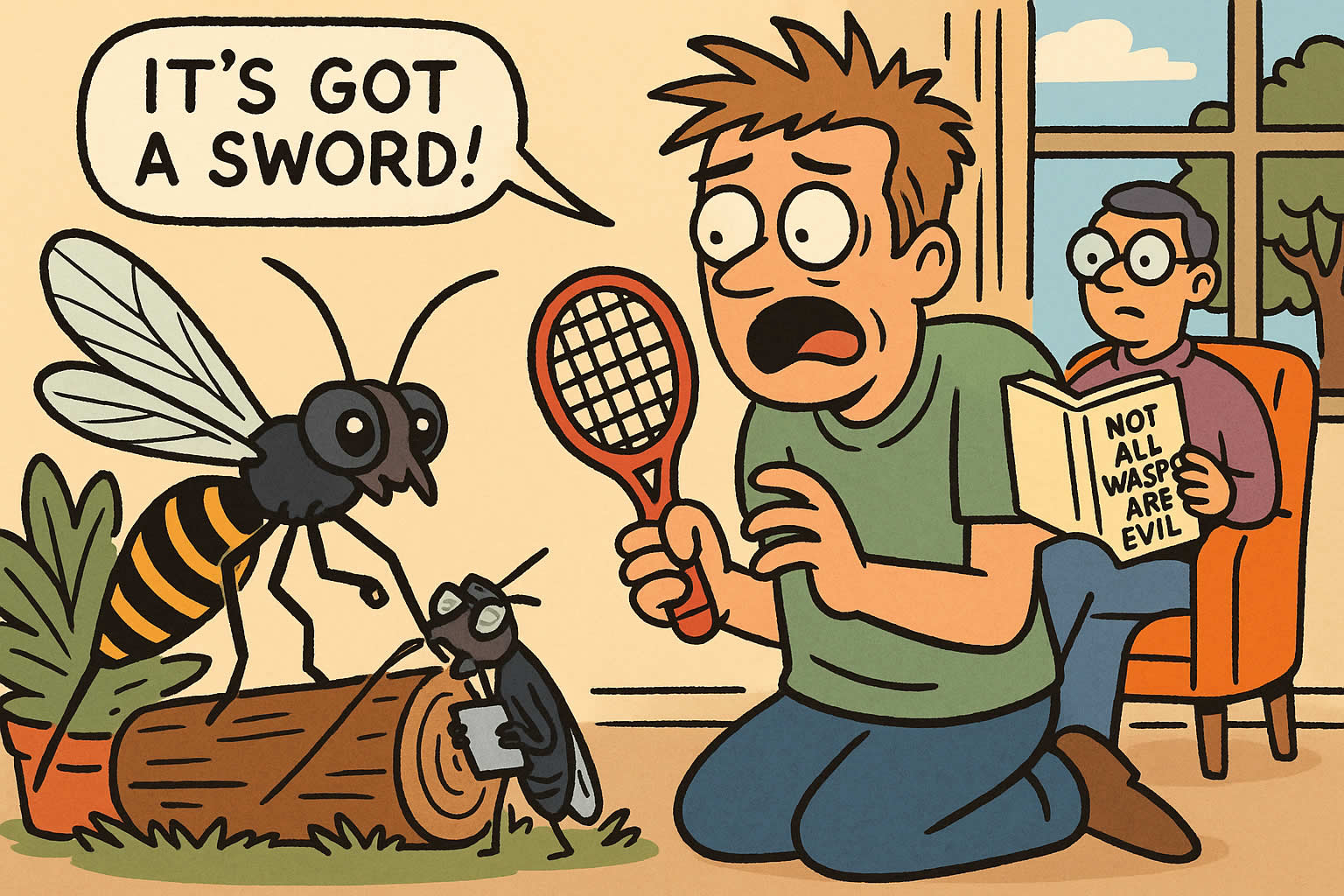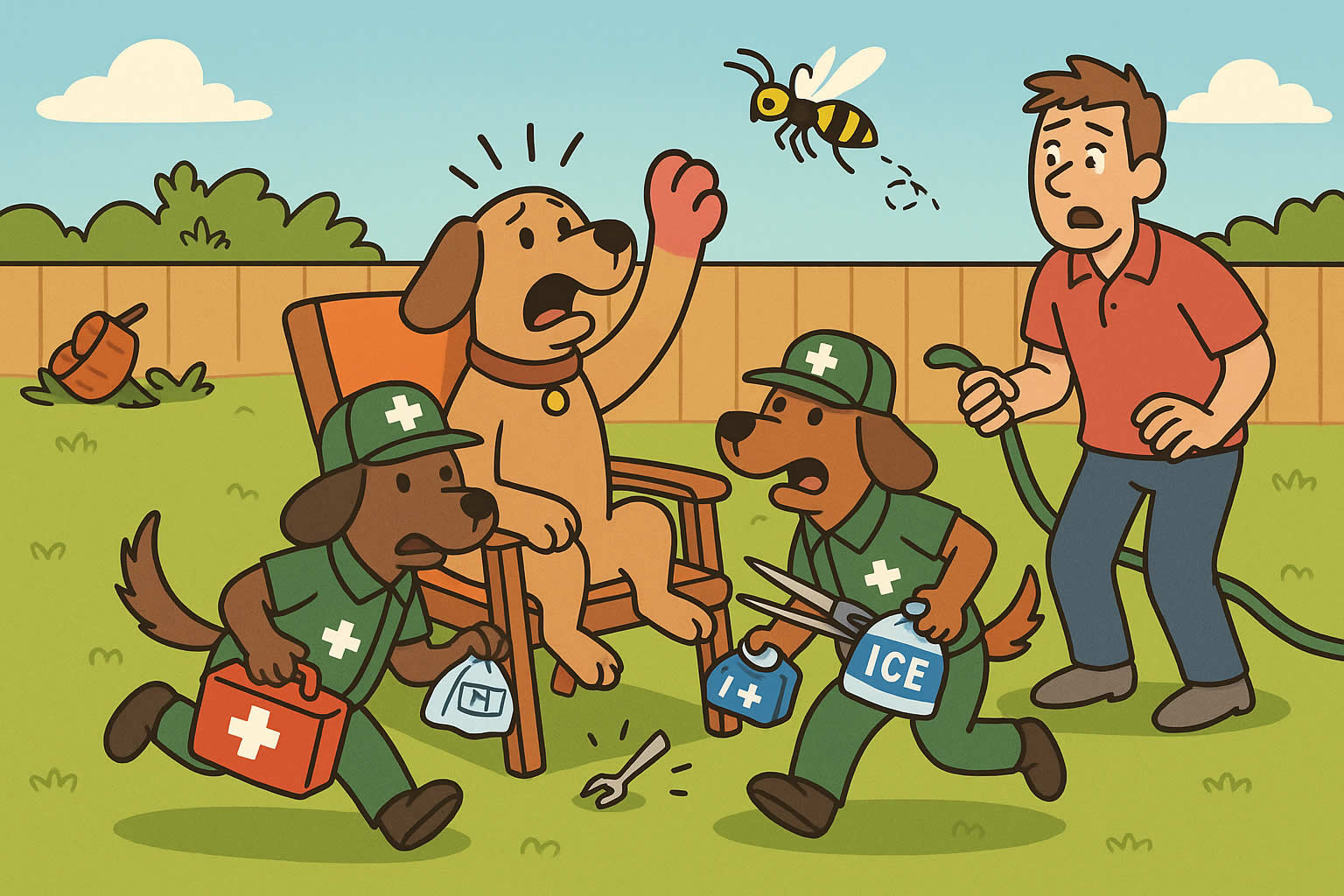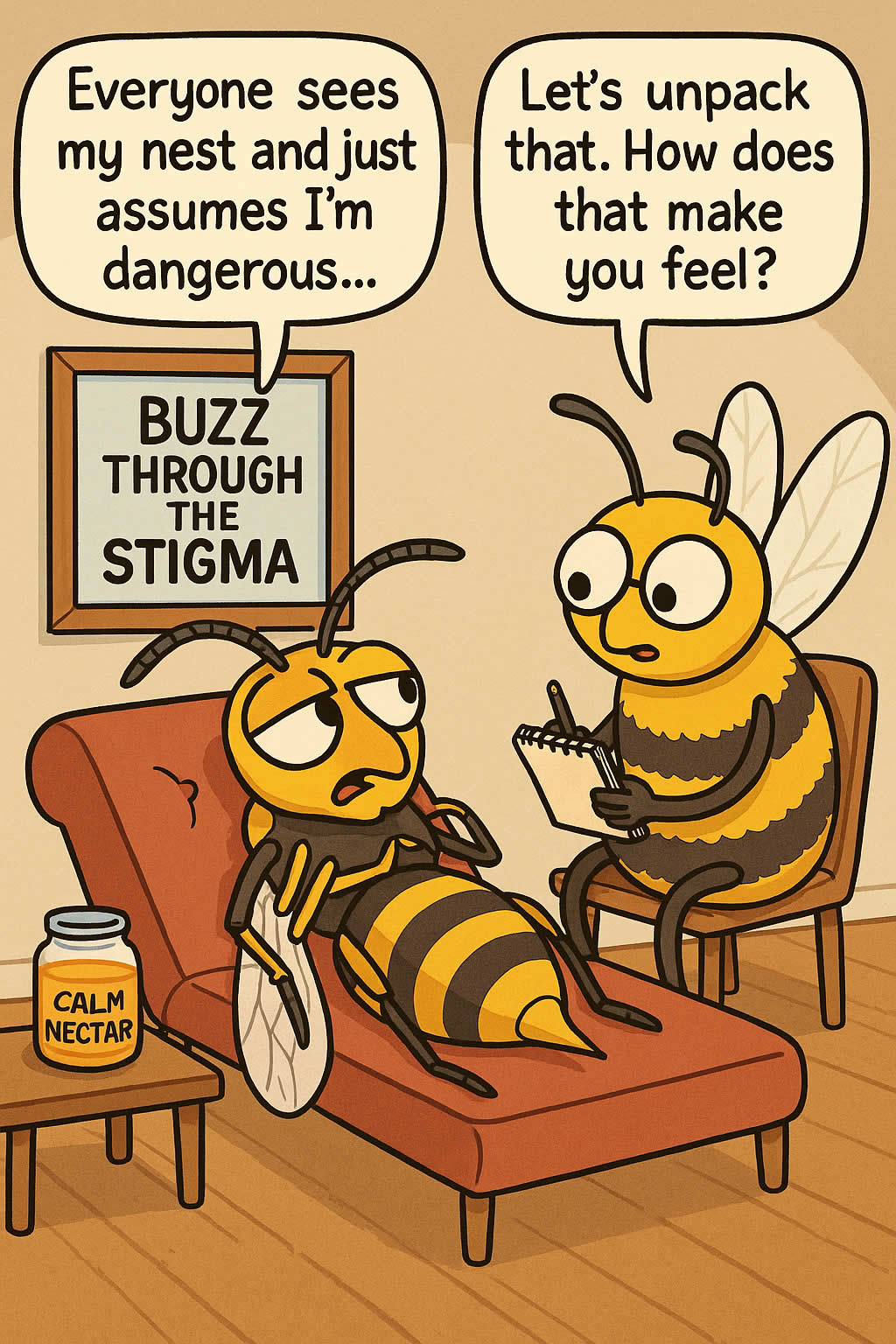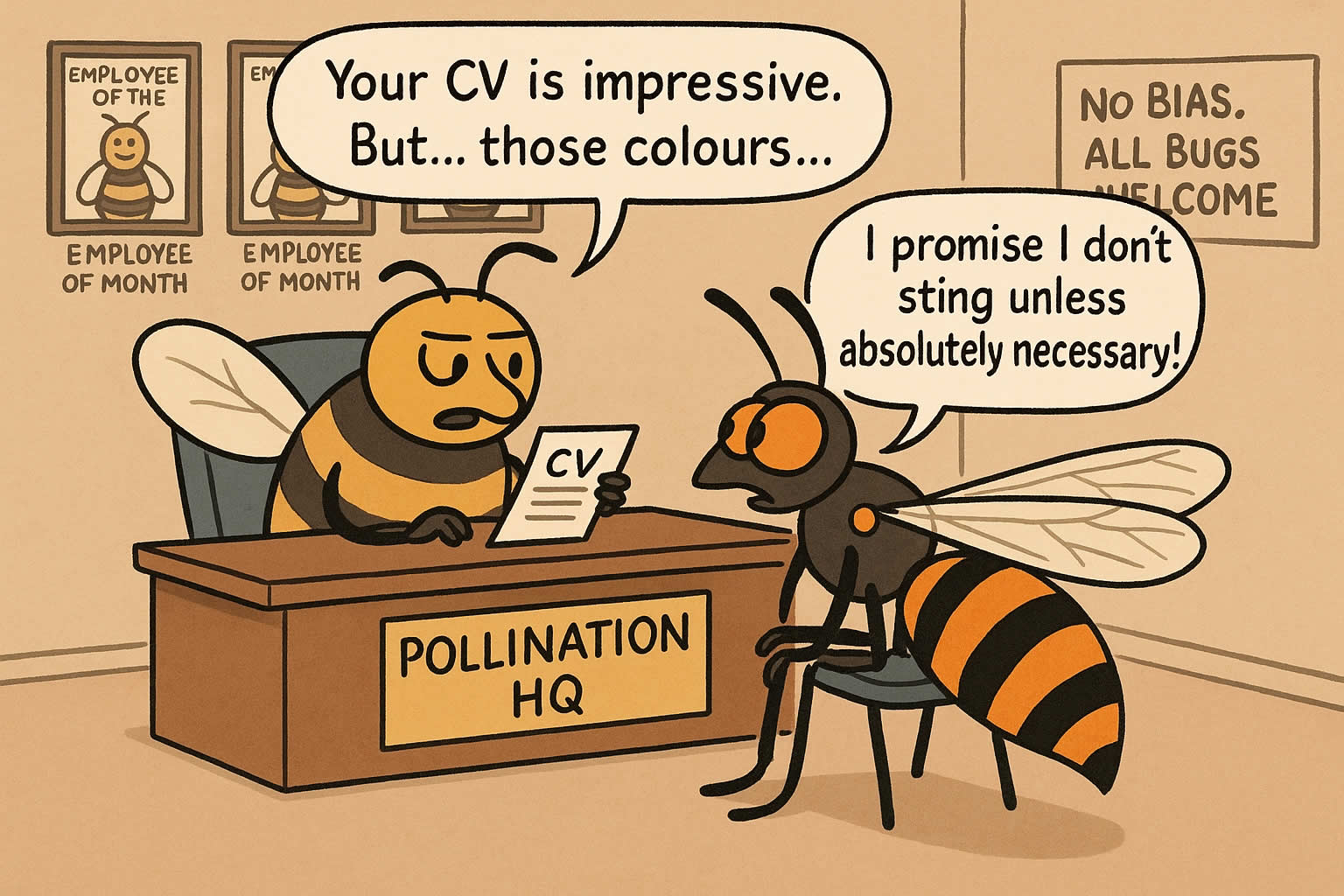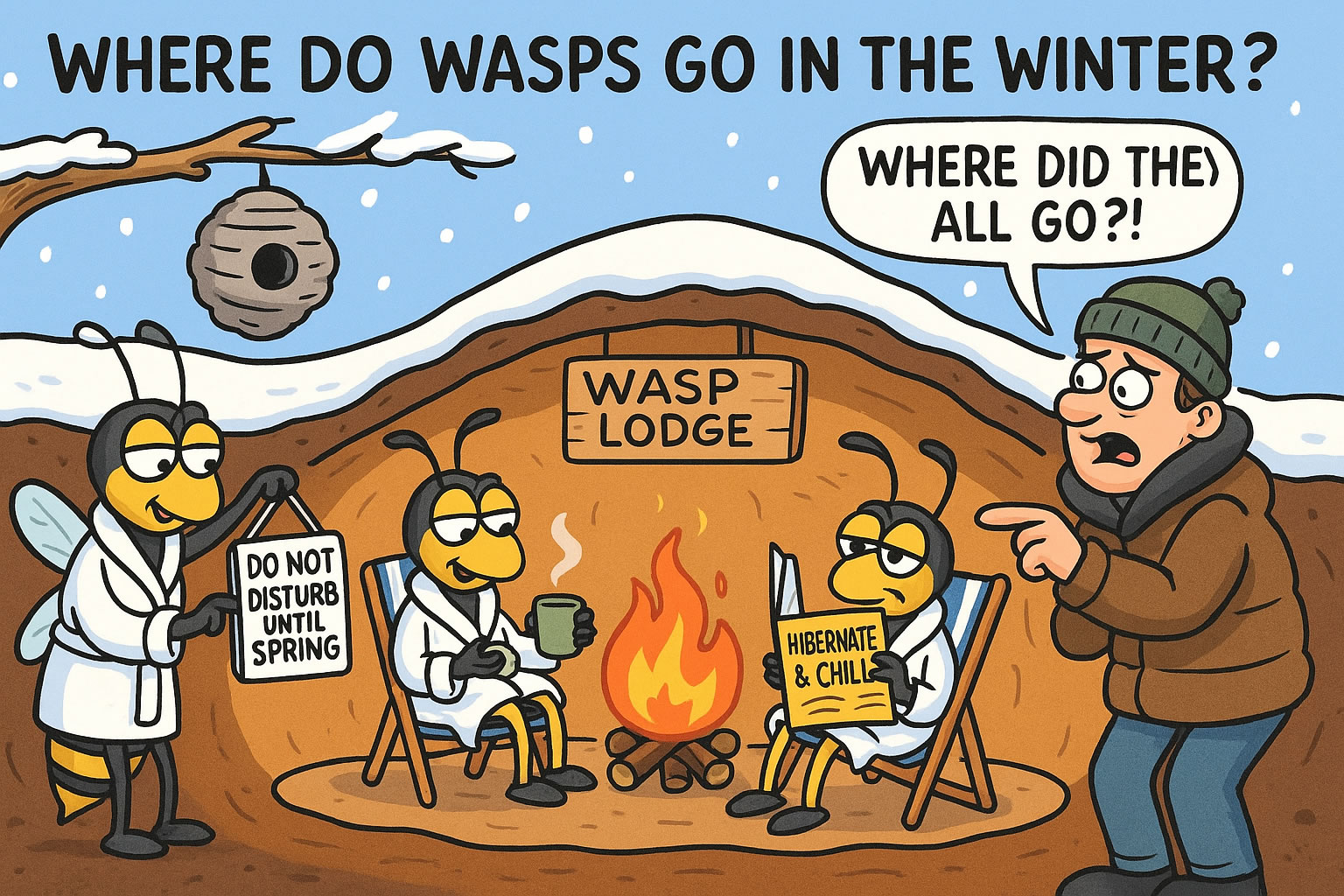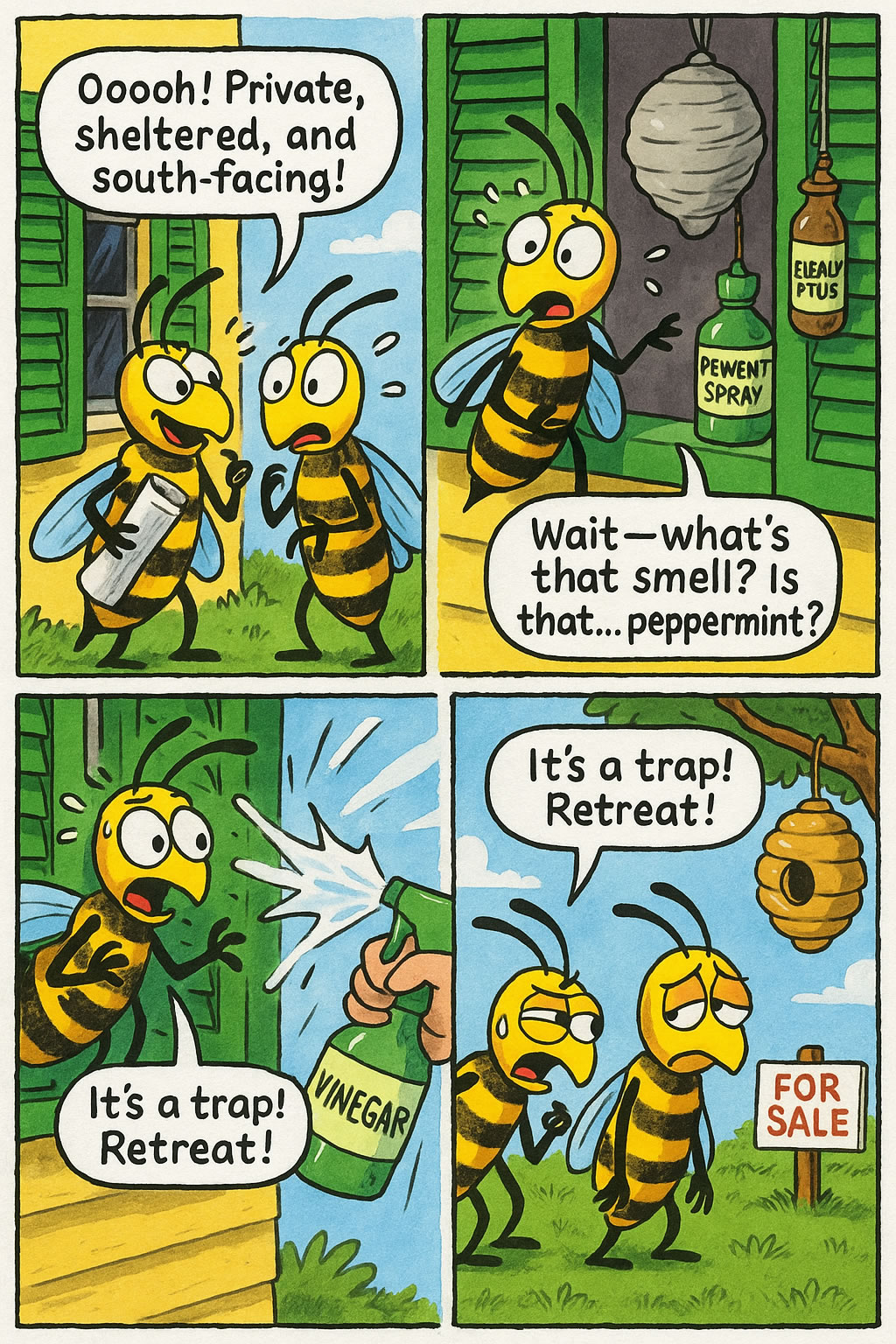Related Queries
ToggleWasp spiders, with their striking yellow and black stripes, might look intimidating, but we can assure you there’s more to these fascinating creatures than meets the eye. While their appearance mimics that of a wasp, these recent arrivals to the UK, first recorded in the 1920s, are actually harmless to humans.
In fact, despite their impressive size—females reaching up to 17mm in length—these spiders cannot sting and possess venom only strong enough to immobilise small prey like crickets and grasshoppers. Originally found in southern England, we’re now seeing these remarkable arachnids spreading northwards, with sightings as far as Shropshire and Derbyshire.
In this guide, we’ll explore everything you need to know about wasp spiders, from their unique characteristics to their behaviour, and most importantly, address your concerns about their interaction with humans.
Understanding Wasp Spiders
The remarkable wasp spider (Argiope bruennichi) stands out among UK’s arachnids through its distinctive appearance and fascinating behaviour patterns. These extraordinary creatures have gradually spread across southern England, making their presence known in various habitats.
Physical characteristics
The most striking feature of wasp spiders is their remarkable sexual dimorphism. Female wasp spiders measure an impressive 14-17mm in length, whereas males are significantly smaller, reaching only 4-6mm. The females showcase a spectacular display of yellow, black, and white stripes across their abdomen, creating a remarkable resemblance to common wasps. Additionally, their legs feature an off-white colouration adorned with dark rings.
Moreover, the combination of their head and thorax is covered with silvery hair. Although less flamboyant, male wasp spiders possess two yellow stripes along their abdomen’s underside, predominantly displaying a pale brown colouration.
Natural behaviour patterns
These spiders demonstrate unique web-building techniques that evolve throughout their lifecycle. Young wasp spiders initially create webs with circular zigzagging designs. Subsequently, as they mature, they incorporate both circular and straight zigzag patterns until finally settling on a distinctive straight zigzag pattern.
One particularly intriguing aspect of their web construction is the presence of a wide, white zig-zag strip running down the middle, known as a ‘stabilimentum’. This unique feature serves a clever purpose – it reflects UV light, effectively attracting pollinating insects such as flies, bees, and moths.
Wasp spiders show remarkable adaptability in their habitat preferences. Although primarily found in grasslands, they successfully establish themselves in various environments, including:
- Coastal areas and farmland
- Heathland and woodland
- Towns and gardens
The mating ritual of wasp spiders presents a particularly dangerous game for males. They must carefully time their approach, waiting at the web’s edge until the female moults into her mature form. At this precise moment, when the female’s jaws are still soft from moulting, males make their daring attempt to mate. Nevertheless, even with this strategic timing, many males still fall prey to their potential mates during this perilous courtship.
After successful mating, females construct silk egg-sacs, which they carefully attach to surrounding grasses. This ensures the next generation of these fascinating creatures can continue to thrive in their chosen environment.
Are Wasp Spiders Poisonous?
Unlike their namesakes, wasp spiders possess a unique venom composition that sets them apart from both wasps and dangerous spider species. Let’s examine what makes their venom distinct and how it affects humans.
Venom composition
The venom of wasp spiders contains acylpolyamines, which represent two-thirds of their dried venom weight. These compounds primarily target glutamatergic excitatory neurons in invertebrate synapses, specifically affecting ionotropic glutamate receptors (iGluRs). Furthermore, certain components can influence nicotinic acetylcholine receptors (nAChRs), though this mechanism mainly serves to immobilise their insect prey.
Interestingly, their venom also contains several enzymes, most notably hyaluronidase, which acts as a ‘spreading factor’ by breaking down hyaluronic acid in tissue. This enzyme helps the venom disperse more effectively throughout their prey’s body system.
Effects on humans
Despite their intimidating appearance, wasp spiders pose minimal risk to humans. Their venom, though effective against small insects, cannot cause serious harm to people. Upon a bite, most individuals experience only mild symptoms, including:
- Slight pain at the bite site
- Minimal swelling
- Temporary discomfort
However, as with many spider bites, individuals with specific allergies might experience more pronounced reactions. Therefore, though rare, allergic responses warrant attention and proper medical care if they occur.
For perspective, it’s worth noting that wasp spiders rank among the UK’s least concerning arachnids regarding human safety. Unlike some notorious species such as the black widow or brown recluse, which can cause significant injury, wasp spiders typically avoid confrontation with humans altogether. In essence, these spiders only bite in self-defence, preferring to retreat rather than engage with larger creatures.
Should someone experience unusual symptoms following a wasp spider bite, particularly those indicating an allergic reaction, seeking immediate medical attention remains prudent. Nevertheless, under normal circumstances, these fascinating creatures present no significant threat to human wellbeing.
Wasp Spider Bite Facts
Most people mistake various skin conditions for spider bites, yet understanding genuine wasp spider bite symptoms and appropriate treatment options remains crucial for proper care.
Bite symptoms
Upon receiving a wasp spider bite, individuals typically experience mild discomfort. The primary symptoms include:
- A burning sensation at the bite site
- A raised, swollen lump
- Localised redness and inflammation
For those with allergies, these reactions might intensify, causing more noticeable swelling and discomfort. Nonetheless, compared to other spider species, wasp spider bites rarely cause severe reactions.
When do they bite?
Wasp spiders exhibit non-aggressive behaviour and only bite under specific circumstances. These solitary creatures resort to biting primarily as a defensive mechanism. Ordinarily, they prefer avoiding confrontation with larger creatures, including humans.
Studies indicate that between 56-94% of people experience insect stings at least once in their lifetime. Yet, wasp spider encounters remain relatively uncommon since these arachnids typically retreat when threatened.
Treatment options
Should someone experience a wasp spider bite, several effective treatment methods exist:
First aid measures include:
- Thoroughly cleaning the affected area with mild soap and warm water
- Applying a cold compress wrapped in cloth for 20 minutes to reduce swelling
- Elevating the affected area when possible
For symptom management, consider:
- Taking over-the-counter pain relievers like paracetamol
- Using antihistamines to alleviate itching
- Applying hydrocortisone cream to reduce swelling
Seek immediate medical attention if:
- The bite occurs near eyes or in the mouth
- Symptoms worsen or persist beyond a week
- Signs of infection develop
- You experience dizziness or severe allergic reactions
Most wasp spider bites heal naturally within a week. Yet, maintaining proper wound care remains essential to prevent potential complications. Pharmacists can recommend appropriate treatments without requiring a GP visit, offering solutions like steroid creams or specific antihistamines based on individual symptoms.
Living Safely with Wasp Spiders
Coexisting with wasp spiders enriches our gardens and helps maintain natural pest control. These remarkable arachnids play a vital role in reducing insect populations, contributing to a balanced ecosystem.
Prevention tips
To minimise unwanted encounters with wasp spiders, consider these effective measures:
- Seal potential entry points around your property, especially cracks in foundations, chimneys, and window frames
- Keep outdoor spaces tidy by removing debris that might attract their prey
- Choose odourless deodorants, as sweet-smelling products can draw insects
- Opt for close-toed footwear in grassy areas where these spiders often build webs
Safe removal methods
Should you need to relocate a wasp spider, proceed with caution. First and foremost, remember that these creatures rarely show aggression unless threatened. For safe removal:
- Wear protective clothing, including long sleeves and gloves
- Approach the spider calmly without making sudden movements
- Use a container and a piece of card to gently capture the spider
- Release it in a suitable habitat away from your living space
For web removal, simply use a long stick to break down the web when the spider isn’t present. Henceforth, regular garden maintenance helps discourage new web construction in unwanted areas.
When to seek help
Professional assistance becomes necessary under specific circumstances:
- Upon discovering multiple webs in living spaces
- If you have young children or pets who might disturb the spiders
- When dealing with allergies or specific health concerns
- If removal attempts prove unsuccessful
The British Arachnological Society welcomes reports of wasp spider sightings, especially during October, as this helps track their response to climate changes. Accordingly, consider documenting your encounters to contribute to scientific research.
For businesses, especially those in hospitality or food service, prompt professional intervention might be required to maintain customer safety and comfort. Even so, remember that these spiders serve as natural pest controllers, so complete elimination isn’t always the best solution.
Straightaway contact your local council if you spot wasp spider nests in public spaces. Meanwhile, maintain a respectful distance and avoid disturbing their habitats unnecessarily.
Are you looking for pest control in Leicestershire? Get in touch with us and a local pest removal company will be in touch.
Our Final Say!
Though wasp spiders might appear menacing with their distinctive yellow and black stripes, we’ve learned they pose minimal risk to humans. These fascinating creatures actually benefit our gardens through natural pest control, making them valuable allies rather than threats.
Understanding their behaviour helps us appreciate their role even more. While females can reach 17mm in length and possess venom, they use it solely for catching small insects. Most importantly, their bites cause only mild discomfort in humans, unlike truly dangerous spider species.
Safety remains straightforward when dealing with these remarkable arachnids. Simple preventive measures, along with careful removal techniques when necessary, allow us to share our spaces comfortably. Additionally, their presence often indicates a healthy ecosystem, as they help maintain insect populations naturally.
Rather than fearing these striking spiders, we should embrace their presence as part of Britain’s diverse wildlife. After all, these recent additions to our local fauna demonstrate nature’s remarkable ability to adapt and thrive in new environments.
Pest Control Carlton – Pest Control Box End – Pest Control Aley Green
